Research on Handicraft Design Based on Artificial Intelligence Technology in Complex Environments
Abstract
In this twenty-first century, research is taking new dimension with the unpredictable development in information technology. With the aid of this technology, handicraft designs can be classified and made by utilizing artificial intelligence techniques. The Chinese handicraft designs will have unique style in the presentation. Using the artificial intelligence techniques, the arc styles of the handicraft design can be identified and classified. In complex environment like epidemic or pandemic situations, every user has to focus on the minor variations in financial aspects. Implementation of artificial intelligent technology will aid the user to get updated with the market strategy for financial allocation to resources. In the market, each arc style may have different demands and the charges will improve the profit for the company and also the country. In this study, the intelligent computer-aided art and craft design (ICAACD) method is implemented on the financial dataset of China and analysis is performed. This proposed system is compared with the existing algorithms such as GNNA, RNNA, and CNNA, and it is observed that the proposed ICAACD method outperforms with the accuracy of 82%.
1. Introduction
Traditional craft products can only grow if they consistently strengthen design innovation and actively respond to the market and their consumers’ needs using modern craft technology. Because of this, the study of traditional craft product design and innovation in today’s intelligent period has immense practical significance [1]. Technology such as computers and other intelligent tool software systems play an important role in traditional craft product design, helping to improve efficiency while also maintaining product quality. Historically, the design of traditional handicrafts was almost entirely based on the manual design process [2]. There were several false problems to contend with, as well as limited design efficiency. It is possible to considerably boost the productivity of traditional craft product design by employing intelligent technological approaches and a variety of professional intelligent drawing design and modelling software instead of manual drawing and manual design [2]. Traditional handmade products can now be completed in smaller amounts with greater precision, enhancing the overall quality of the design.
Craft products that incorporate intelligent technology into their design also have a positive impact on product innovation. Traditional craft model-based product design models can be transcended by the power of intelligent technology, allowing for new product forms [3]. Traditional handicrafts can also benefit from the advantages of intelligent technology, such as its high interaction and variety of forms. It is possible to use intelligent technologies to mould objects to incorporate features such as intelligent product information display, speech, and automatic adjustments. Promoting traditional handicrafts is a strategy for long-term growth [4]. Multiple clever and current technical means have substantially improved the design effectiveness of traditional handmade goods. Traditional craft goods’ structural qualities and design requirements necessitate flexible use of intelligent design platform and accompanying tool software in the age of intelligence [5]. Traditional craft products are being reimagined with the help of computer and sensor technology in order to incorporate professional sketching and modelling tools [6]. Sensors and actuators, such as motors and LEDs, can be connected to the motherboard using a variety of universal standard connector ports. Designers need just to input a professional computer program to complete the design of traditional craft products automatically, consistently, and in batches [7]. In order to maximize economic benefits, the traditional process product can be greatly lowered in design and production costs.
It was easier to cause the designer to block product design and customer demand in the news since there were few designers who could connect with customers and other people in traditional handmade product design [8]. In the contemporary age of intelligence, open intelligent design systems and other new media can be used to enhance the engagement between designers and clients, product manufacturers, and process learners [9]. Communication, learning, and design all go hand in hand to produce traditional handicrafts that are both efficient and innovative. In the case of a traditional craft product, for example, the shape, structure, and colour of the object are often copied from its predecessors. Live webcasts, digital cameras, and video recording equipment, as well as methods such as sending bullets and likes to engage the audience, all of which are aimed at increasing the public acceptance and use of traditional handmade items, can also be employed [10]. The following considerations must be taken into account when creating traditional craft items, and designers can also take advantage of the interactive capabilities of the intelligent design platform to keep tabs on the people who are buying and making them [11]. If you are going to increase the quality and inventiveness of traditional handcrafted things, you are going to have to pay attention to their advice on product design and understand exactly what the problems are [12]. It is possible to create intelligent products employing a wide range of highly intelligent technologies. Many designers and their clients are using the intelligent design platform to complete product modelling, colours, and other areas of efficient information sharing in order to further boost product design efficiency [13]. Effective innovation in the selection of materials can help traditional handmade product design. In addition, 3D printing or other smart sensors can be utilized to access more resources for product design and effectively regulate the cost of product design materials [14]. In addition, clever technology can be used to enhance the distinctiveness of traditional artisan objects by adding new intelligent characteristics.
Sound can be made by tapping on bamboo weaving craft goods, such as a singing or dancing instrument [15]. When designing using intelligent technology, designers have access to a wide range of vibration and ultrasonic sensors, as well as an intelligent design development board and LED lights with self-programming control software [16]. Plastics and electronic components are also among the materials that have been utilized in this project. Playing music can be done by voice command, touch command, or other methods, and the lighting can be altered to produce different lighting effects, integrating sound and energy [17]. An APP on a mobile phone can now be used to remotely control traditional craft products using Internet of Things (IoT) technology, wireless transmission technology, and other intelligent hardware and software based on this foundation. Economic globalization has led to an increase in competition in the handicraft industry. Successful handcraft enterprises rely on improving labor productivity by keeping pace with improvements in science and technology [18]. High-level advantages in global competitiveness are based on product quality innovations, product development innovations, brand innovations, and cultural innovations. In the handicraft industry, the number of well-known brands is very small, and only a handful have a presence outside of the country [19]. As an intangible asset, “brand” is used to characterise a product’s added value, which includes everything from the product itself to the company’s innovation to its management to its positioning in the market to its marketing. Independent brands can propel the handicraft industry to the top of the global value chain. Traditional media consumption has declined, and the frequency of Internet use has increased, offering a substantial challenge to the brand management of traditional handicraft enterprises [20]. Due to increased prices, craft businesses confront additional challenges. Living standards and wages for workers have increased, which has led to an increase in labor costs. Handicraft firms must change their distribution techniques to keep up with the rising cost of materials and transportation. This practice has resulted in astronomical costs in China’s department store retail industry for many years now. Because of escalating prices, the department store business has concluded that it must change and aggressively build its own brand. Sales channels like the Internet and online shopping are stepping up to increase their territories at the same time that other sales channels are expanding their territories. More success can be had by coming up with a new business strategy that both lowers distribution costs and helps customers [21].
Traditional handicraft enterprises spend a lot of time and effort analyzing consumer preferences, designing products, producing, and selling them. In many circumstances, a product’s peak popularity period has gone or the season has changed by the time it is officially launched. This has a negative impact on the business [22]. There must be months of preparation before a product launch in the traditional handcraft business, and production might begin as early as this year for next year’s product [23]. A miscalculation of the market, in addition to wasting time and resources, can result in a large backlog of inventory. Organizations throughout the world are making supply chain management a priority as a means of increasing their competitiveness in the twenty-first century. It is also worth noting that existing supply chain practices in the crafts industry are unclean. There is a disparity in supply and demand between and within each process unit [24]. This ideal level of delivering things on time, in the appropriate quality, and in the right quantity is extremely difficult for the supply chain to attain. To schedule output in accordance with market demand, it is challenging because of information resource sharing and delayed feedback. Since its inception on the Internet, e-commerce has quickly become a new method of commercial operation and a new means of market competition [25]. For enterprises, cross-regional or even global markets have become possible thanks to technology breakthroughs like computers and networks, which have made e-commerce conceivable. The craft industry’s supply chain is characterised by fast market changes, order-oriented production, a short supply chain cycle, difficult product information management, and an international ecosystem [26]. To compete in today’s market, the rapid rise of electronic commerce and information technology is necessary to improve global trade channels and reduce transaction costs, simplify company procedures, and shorten production cycles.
Making use of the Internet, custom-designed crafts can be better suited to the individual needs of each buyer [27]. Now that information technology makes it possible to connect and communicate one-on-one with individuals and has rendered obsolete the previous practice of understanding customers’ needs based on their age, one-to-one product services over the Internet are poised to be a new growth area for the market. The high brand value will be developed in the fields of personalised services and products, as well as “personalised products.” To remain competitive in the future, it will be more difficult to distinguish items based on features alone rather than on their whole worth [28]. It will be replaced by an ongoing process of updating consumers rather than relying on prelaunch planning and forecasts for manufacturers, who will have to adapt to this new marketing model. Competition is expected to focus on the ability to promptly accept orders and deliver products to clients as requested [29]. This study aimed at evaluating the implementation of artificial intelligence technology in making handicraft designs.
- (1)
It focuses on the development of artificial intelligence through computer-aided art and craft design.
- (2)
It also discusses the fundamental ideas of computer-aided art and craft design.
- (3)
It also proposed the intelligent computer-aided art and craft design (ICAACD) method for evaluating the financial performance.
- (4)
It also analyzes the accuracy of the arts and crafts and knowledge base, and the performance of the work can be improved which will aid in the increase of finance for the artworks.
2. Materials and Methods
The Global Chinese Development Financial Dataset is considered in this research. This dataset has covered financial information of various sectors; among those sectors, the market rate of the Chinese image is considered for analysis. With the ongoing developments in computer technology and digital technology, the concept and method of computer-aided art and craft design had also advanced quickly. Utilizing artificial intelligence concepts along with computer-aided processes in art and craft design seems to be a recently developed popular research area, as is the automotive engineering modernization development. Also, this can replace computer-aided art and craft design with artificial intelligence technology. Furthermore, the expansion of this merged artificial intelligence technology in almost all applications allows helping in promoting development in major sectors. This paper focuses on the development of artificial intelligence through computer-aided art and craft design as well as briefly discusses the fundamental ideas of computer-aided art and craft design.
2.1. Architecture for the Proposed System
The development of information technology towards artificial intelligence is tremendous. This development has made artificial intelligence step into various domains and provide massive support for the humans. The architectural diagram of Figure 1 represents that arts and crafts and knowledge-based designs can be supported and developed with the aid of artificial intelligence. In this research, the financial status of the handcraft designs is considered. Each of the arts and crafts and knowledge-based designs will have different strokes and curves. The usage of strokes and curves makes the design unique, which will determine the design’s cost. The persons in the education sector will have a broad knowledge of the traditional arts and crafts work. Hence, the analysis of the work can be performed using algorithms for simulation or some models. As an extension of the arts and crafts, the concept of knowledge base can be implemented. This knowledge base will provide different dimensions to the traditional one with the utilization of two-dimensional, three-dimensional, or objects, frames, and so on to improve the accuracy of the financial aspects of the artworks. The accuracy of the arts and crafts and knowledge base can be analyzed, and hence the performance of the work can be improved which will aid in the increase of finance for the artworks.
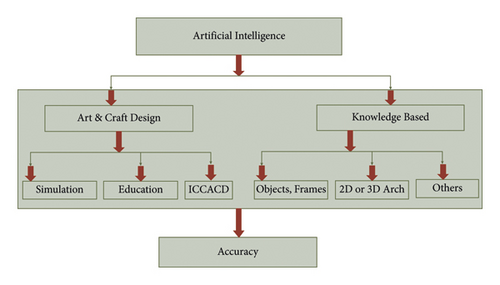
2.2. Motivation of the Study
With the unpredictable development of information technology, research is taking on new dimensions. Handicraft designs can be classified and created using artificial intelligence techniques with the help of this technology. In the presentation, the Chinese handicraft designs will have a distinct style. The arc styles of handicraft design can be identified and classified using artificial intelligence techniques. Each arc style may have different market demands, and the charges will increase the profit for the company as well as the country. In this study, the intelligent computer-aided art and craft design (ICAACD) method is applied to a Chinese financial dataset and analyzed.
2.3. Proposed Work
Another implementation of artificial intelligence in computer-aided art design is a correlation-based technology. A correlation-based model is a mathematical tool used to solve uncertain and ambiguous difficulties. In concept, “knowledge” is regarded as a type of object classification possibility. A multiple decision chart is typically used to classify information. Each column demonstrates an attribute, and every line indicates an object, so each format describes a piece of information about the object. Conditional attributes, as well as decision attributes, are the two types of attributes. Objects in the field are classified into judgment classes, each with its own set of selected attributes based on the circumstance attributes.
When A = 0 is used, the sequence is high-resolution, with just two lighting as well as darkness levels. When A = 1 is used, then the pattern has a low resolution of 16 colours or 17 grey levels. A + 1 is the quantity of marked by strong in the basic figure. C, M, and E are intersecting graphical variables. T0 − T5 are the basic graphics which are the selectable parameters. It is repeatedly the graphical representation that are copied in the vertical direction and considered as the background or background luminance of a graphics.
Geometric vertices (the percentages of edges have to be larger than two and less than seven) can also be integrated within the interconnected graph. The interconnected transformation method of nine illustrations can be formed by the symmetrical principle and the consistent linear evolution. These interconnected graphs can take nine different paths. The fundamental rule for diagrammatical transformation matrix, as well as the algorithm for trying to generate interlocking graphics, is briefly discussed in equation (8).
- (1)
Transition of translation:
() -
where (nv, mv) and are the reference points of every defined location in between translation, in both. The interpretation of the reference points are converted by equation (11) into the Z convolution.
- (2)
Proportional conversion:
() - (3)
Rotation transition centered ability are addressed by the following equation:
The wavelet transform decided by equations (14) and (15) is represented as the as well as converters. Excluding the K transition, some other six transitions are used for the renovation of an interconnected sequence travel in groups. Since only half of a line group created by a K convolution is self-sufficient, it shapes its own curve set.
The invention of artificial intelligence will have transformed the design of computer-aided arts and crafts, replacing a great deal of routine and boring manual labor and improving overall productivity. Artificial intelligence technology is constantly being improved. Different technologies and algorithms have resulted in computer-aided art and craft design being much more advantageous, cost-effective, and efficient. In contrast, productivity and effectiveness are both improved, pointing the way forward to advance artificial intelligence technology. Artificial intelligence algorithms yield excellent results that will require computational application power and the proposed experimental apparatus.
3. Results and Discussion
The paper describes the design of a willow innovation data preprocessing algorithm (WIDPA), beginning with the software framework of limitless options model production and progressing to the algorithm’s realization process. It then explains how to use the education graphics postprocessing framework and splice the digital shadow following code to form a comprehensive willow art and craft design document (refer to Figure 2). The major function of this willow algorithm is to make the differentiation among the curves and stroke styles. The intelligent computer-aided art and craft design (ICAACD) method is simple to analyze with the aid of willow algorithm and is implemented on the Chinese financial dataset, and the analysis is done well and provides the exact result. In complex environment such as epidemic or pandemic situations, every user has to focus on the minor variations in the financial aspects. Hence, this algorithm can be implemented to get improved results.
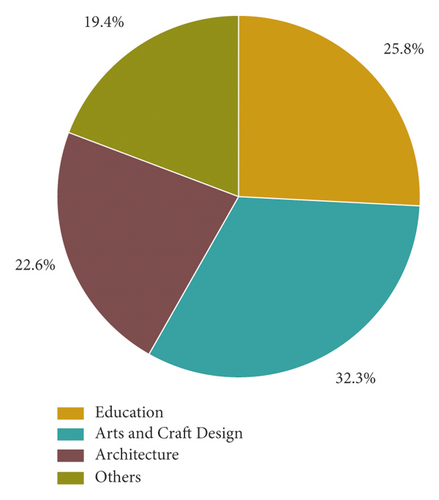
Finally, the performance and efficiency of such an algorithm are evaluated for education, and the algorithm’s user-friendliness is verified. From this figure, it can be observed that art and craft design has occupied a major partition of 32.3% for computer-aided design market. It can be further assessed to obtain improved performance.
Table 1 depicts the most common PC series as well as Z panel combinations, as well as their variability. The main transformation stream includes reflection conversion along with the line m = n and along the axis with (–1,1) ratio and a 45° precession. It is also essential to obtain the details about the collective representation while converting each graphic designer unit into such an interconnected diamond pattern.
| Conversion | The well-known point | Points for being alone | Belonging place | The lonely line | Line of belonging | Variability | Circumstance |
|---|---|---|---|---|---|---|---|
| Absence(n, m) | n(0) = 0 | n(1) | n(2) = n(1) + 25 | 02 | 47 | Absence(n, m) | n(9) = m(9) = 0 |
| m(0) = 1 | m(1) | y(2) = y(1) + 4 | 15 | 59 | n(4) = 0.26n(1) | ||
| n(4) = 60 | n(5) | n(5) = n(2) − n(3) + 2 | 25 | 05 | m(4) = 0.26 m(1) | ||
| M(4) = 15 | m(5) | m(5) = m(2) − m(3) |
Arts and crafts can use artificial intelligence (AI) to create maximum visualizations. Simulated accuracy results appear to work by combining (education, art and craft design and architecture, and others) multiple designs and creative thought based on the procedure and illustration materials and present sufficient collected data underneath the assumption of establishing expectations and objectives. Art and craft architecture becomes more potent with AI as more infrastructure and modularized structures, such as big data, Internet sites, applications, and digital services, are added. Whenever one increases accessibility with another, large data are generated. New efforts will result in new knowledge, and new motivation will result in a virtuous creative cycle (refer to Figure 3). The data processing is becoming increasingly complex, resulting in a more accurate and actionable dataset. It will also aid art and craft architects in making more science design processes as well as re-engineering their tasks.
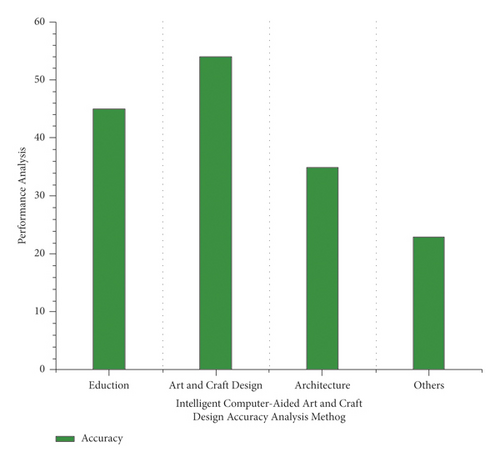
The application and the growth of convolutional neural networks (CNNs) are playing the most essential and powerful intelligent role in arts and crafts. Convolution is commonly used in image analysis. The communication system is also used to determine the sequence algorithms, Google image, recommendation service, and personalised sharing of web page information. The high qualities of information procedure, image classification, and generation are considered the first indication of AI’s transcendence to arts and crafts (refer to Figure 4). AI outperforms humans in terms of capability, accuracy, and bandwidth. AI outperforms humans in terms of capability, accuracy, and bandwidth. Conventional arts and crafts have unlimited innovation within the AI environment. However, capitalizing on knowledge formation and education through space and realizing the multi-dimensional (2D and 3D) transition to some limited year (2014–2020) may be extended to massive data and instruction applications.
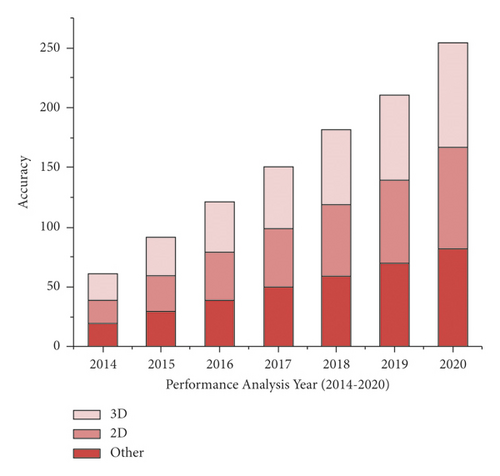
In addition, users are evaluated by analyzing the three methods introduced in the previous seven years, Graph-based Negative Neutrocytic Ascites (GNNA), Ribonucleic acid Negative Neutrocytic Ascites (RNNA), and Culture-Negative Neutrocytic Ascites (CNNA). These methods are then compared with the ICAACD to investigate our methods’ efficacy. Figure 5 depicts the results. We can see that the dark curve presents the result of an ICAACD method, while the other three curves demonstrate the results of all the other three methods. It can be seen that our proposal outperforms all those on all datasets excluding D4, proving that all methods produce similar results. GNNA consistently produces poorer results, which may be due to lower generalization, but it will provide that much differences. CNNA, in its most basic form, has the lowest accuracy as well as diversification. RNNA is in the center of them all. The ICAACD method can also provide high scores as well as more variability, resulting in more innovative products (refer to Figure 5). It demonstrated that ICAACD outperformed other three methods.
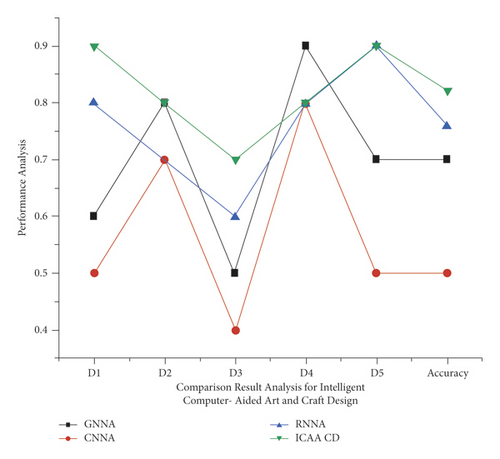
The growth of evergreen technology's dataset (D1-D5 each data contains 1000 records) is preprocessed. Intelligent computer-aided art and craft design (ICAACD) is analyzed with different algorithm for the application structure in the context of limitless options model production. The ICAACD algorithm’s moment realization process explains the usage of graphics post-processing framework and slice the digital edge test scripts to develop a full classic hand-made file. Eventually, the efficiency and effectiveness of such as Intelligent Computer-Aided Art and Craft Design algorithm are evaluated, and the algorithm's perceived usefulness is validated and evaluated too far (Table 2). The accuracy of the proposed method is observed to be 82% which is higher when compared with other existing methods.
| Dataset | GNNA | CNNA | RNNA | ICAACD | ICAACD accuracy (%) |
|---|---|---|---|---|---|
| D1 (1000 records) | 0.6 | 0.5 | 0.8 | 0.9 | 98.34 |
| D2 (1000 records) | 0.8 | 0.7 | 0.7 | 0.8 | 99.45 |
| D3 (1000 records) | 0.5 | 0.4 | 0.6 | 0.7 | 98.99 |
| D4 (1000 records) | 0.9 | 0.8 | 0.8 | 0.8 | 98.67 |
| D5 (1000 records) | 0.7 | 0.5 | 0.9 | 0.9 | 99.12 |
| Overall accuracy | 0.7 | 0.5 | 0.76 | 0.82 | 98.97 |
4. Conclusions
The study focused on how the artificial intelligence technology helps in classifying and making handicraft designs in complex environments. The integration of handicraft design and AI will become the most demanding future technology. AI offers several ways to express the creativity of present arts and crafts. AI offers several ways to express the creativity of present arts and crafts. It enhances the new cultural forms of crafts and also fosters the enhancement of innovative methods and thinking. This study proposed the intelligent computer-aided art and craft design (ICAACD) method for evaluating the financial aspects of handicraft design. The study results proved that the proposed method performs better than existing algorithms.
Conflicts of Interest
The authors declare that they have no conflicts of interest.
Open Research
Data Availability
The data used to support the findings of this study are available from the corresponding author upon request.




